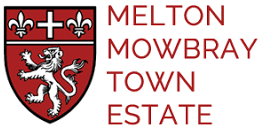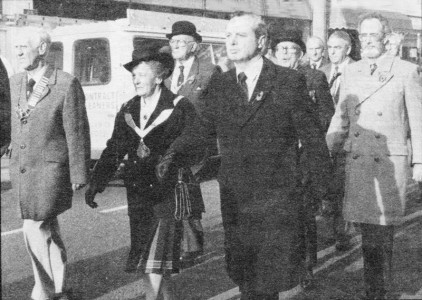[vc_row][vc_column][rev_slider_vc alias=”animals”][/vc_column][/vc_row][vc_row][vc_column width=”1/2″][vc_text_separator title=”Coat of Arms” color=”green”][vc_column_text]
Enquiries began in 1973 concerning a Coat of Arms for the Town Estate.
Since the latter part of the last century the Town Estate had, with others, made illegal use of the Silver Lion Rampant on a red shield, from the Mowbray Arms.
After considerable correspondence with Lord Mowbray, Seagrave and Stourton, and the Richmond Herald of Arms, Mr J P Brooke-Little, and much patient work by Mr Gilbert King and Mr D A Taylor, the above design was approved by the Kings of Arms.
The cross in the design is the silver cross of the Knights Hospitallers of St John of Jerusalem, some of whose land was acquired by the Town Estate in 1549.
The fleur de lys was the symbol of the “Guild of our Layde” which helped in the establishment of the Town Estate.
Letters patent were handed over to the Townwardens at a ceremony held in Melton Carnegie Museum on 13th May 1978, at which were present Lord Mowbray, Richmond Herald of Arms and the Lord Lieutenant of Leicestershire.[/vc_column_text][vc_text_separator title=”Jubilee Fountain” color=”green”][vc_column_text]
As with water supplies, the state of public lighting varied considerably from place to place and Queen Victoria’s Jubilees provided the opportunity to make improvements.
Melton had a drinking fountain with a lamp designed by George Smith of Glasgow to commemorate Victoria’s Golden Jubilee 1887. It graced the Market Place in Melton Mowbray. Costing £26 17s 10d and made of cast iron, the structure was supplied virtually ready for on-site erection by George Smith and Co, Ironfounders of Glasgow, with the installation work carried out by local builder C. Barnes, John Anderson plumber & glazier, and the Melton Mowbray Gas Light and Coke Company. However, the new fountain proved unpopular with the local tradesmen who successfully campaigned for its removal to the Play Close, where it remained until going for scrap during World War II.[/vc_column_text][vc_text_separator title=”Our Archives” color=”green”][vc_column_text]
[/vc_column_text][vc_btn title=”Read our archives here” color=”green” align=”center”][vc_text_separator title=”Our Previous Town Wardens”][vc_column_text]
[/vc_column_text][vc_btn title=”View our previous Town Wardens” color=”green” align=”center”][/vc_column][vc_column width=”1/2″][vc_column_text]This is a brief History of the Town Estate with extracts taken from research that has appeared in previous Town Estate publications.
14th Century – Local Government under the Guilds
During the fourteenth century there grew up a number of Guilds, founded from religious motives, but growing in secular power as they acquired property through endowment or otherwise. In addition to their religious activities, many Guilds carried out functions akin to local government, including education. Their power and possessions proved too much of a temptation as an opposition to the Crown and hence the attack on them and appropriation of their property known generally as the “Dissolution of the Monasteries”, carried out by Thomas Cromwell for Henry VIII in the late 1530’s.
For example, in Melton the property known as The Manor of Lewes was given to, or taken back by Thomas Cromwell. On his execution in 1540 it was given to Anne of Cleves as part of her settlement on the annulment of her marriage to the King. Anne of Cleves’ House in Burton Street was probably a Guild or Chantry House for the residence of Priests.
There seems little doubt that the beginnings of the Town Estate in Melton Mowbray were due to a desire by the Town to retain the material benefits of the Guild system, including the provision of a school and to perpetuate the system of local government developed through the local Guilds of St. John and St. Mary. The Church provided the wherewithal for the beginnings of the Town Estate, in that the money used by the Town to acquire the first land for the Estate, came from the sale of silver and plate belonging to the Church.
1549 – 1850 – Local Government under the Town Estate
The Melton Mowbray Church Wardens’ Accounts of 1549 record:- “Paid by Nicholas Colishaw to Christopher Draper of London” 21st November 1549 “ffor a parsell of land with appertennces lately called the cheippel house in Melton bought of the Town of Melton use”. Colishaw and his colleague purchased for £21.00 land known as Chapel Close (roughly, part of the site now occupied by the Cattle Market); the two men conveyed this land to 20 local men to hold as Feoffees (trustees) for the benefit of the Town in general and the school in particular. The terms of the Trust were that the annual rents and revenues of the property were “annually and for ever to pay and contribute to the support of a school master to teach and instruct boys in grammar in Melton Mowbray”.
After the purchase of the “Chapel Close” in 1549 and “The Spinneys” in 1564, the Town Estate revenue was largely used for the upkeep of the Free School. In addition to the Free School by 1575, or thereabouts, there also was a Grammar School. Changes in 1582 saw the 20 townsmen reduced to 12 Feoffees and 2 Townwardens. The Town Estate was by now to a large extent the local government. As early as 1582 it had taken over the upkeep of local roads and bridges and many local offices were instituted. By the end of the 16th century the Town Estate had considerable property, these included shops and houses in the town centre and large areas of grazing land. In 1850 it purchased for £650.00 the rights of the Lord of the Manor of Melton Mowbray; this allows the Estate to run the Street Markets and also gives the Senior Townwarden the title Lord of the Manor.
1869 – Hand Over of Duties
In 1869 the land at Spittle Leys (Scalford Road) was leased to the Local Government Board for 999 years for £50.00 per annum; at the time this was a benefit to the people as the markets took place in the streets. In Spital End (now Nottingham Street, near to the old Baptist Church) stood the “Shepe Cross” or Sheep Cross where the sheep market was originally held. On Cornhill, at the junction of High Street and Nottingham Street, where the newly erected Corn Cross stands, the corn market was held. In 1986, the original base of the Butter Cross (including time capsule beneath) was re-erected in the Market Place, with a new “stone shaft and head”. The Butter Cross is believed to be on the original site of the old Saxon Cross. The original ‘head’, is in safe-keeping in the church and was for many years used as a door stop. On this site for many years until 1914 the Annual Cheese Fair was held, when pyramids of Stilton Cheese stood in the Market Place.
The Beast Market was held outside “The Limes” (now Woolworths) in Sherrard Street. Pens were erected in the streets and the drover came in on foot; terrible messes were left behind. It was quite a relief for the towns-people when it was moved to the outskirts of the town!
19th Century to Present Day
The hunting of the fox has been synonymous with the name of Melton Mowbray for more than two centuries. The territories of the Belvoir, Quorn and Cottesmore Hunts all adjoin at the Market Place. Amongst the host of celebrities who met here are four kings, who, in their earlier years, hunted from the town and district. George IV, Edward VII, Edward VIII and George VI and our Prince Charles is following this tradition.
Today land and property of the Town Estate include:
Play Close purchased in 1866 for £170.
A further field to enlarge this area in 1872 and the southern side of the old canal bed in 1886.
In 1907, the paddock in Leicester Street was added for £200.
Lady Wilton sold a field on Leicester Road for £400 which became Leicester Road Sports Ground.
The Gardens of Egerton Lodge (now Memorial Gardens) were purchased in 1929 for £500.
In 1949, The Bickley Trust purchased for £3,000 and gave the Town Estate the All England Sports Ground on Saxby Road to fulfil a wish of J.W.C. Bickley. An extract from the Last Will and Testament – “If possible purchase the Old England Ground and lay out for the purpose of first class cricket, for the benefit of the inhabitants of Melton Mowbray”.
In 1936, the Land in Kings Street including the site of the Kings Street College, was let on a 299 year lease to Leicestershire County Council at a peppercorn rent of five shillings (25p) per annum.
Asfordby Road Golf Course – 37.82 acres of land purchased in 1972 following the sale of land on Dalby Road.
In 1986 Pedigree Petfoods marked its association with Melton Mowbray by officially presenting Priors Close to the Town.
Land on Kirby Lane, Dalby Road and Nottingham Road.
Land at the top of Windsor Street and site of Peter Pan House, Chapel Street.
Glory Hole, back of Bus Station, Wilton Road – site of the Toy Soldiers Bandroom, Scout Hut and Market Stall store.
Town Bailiff’s Cottage, Park Lane – Town Estate Admin. Offices.
The Objects of the Town Estate are always for the benefit of the people; today sport organizations, charity groups and schools are often subsidised and in some cases pay only peppercorn rents.[/vc_column_text][/vc_column][/vc_row][vc_row][vc_column][/vc_column][/vc_row]




